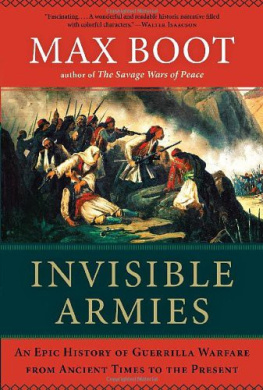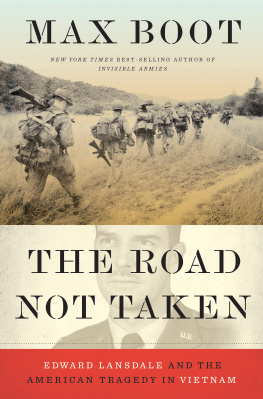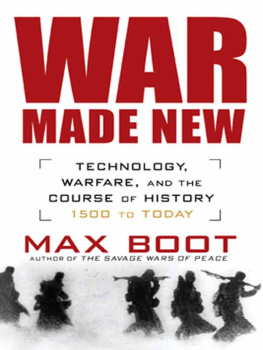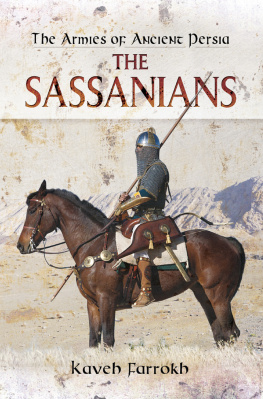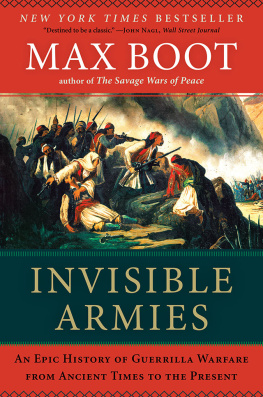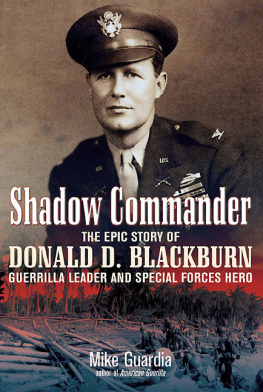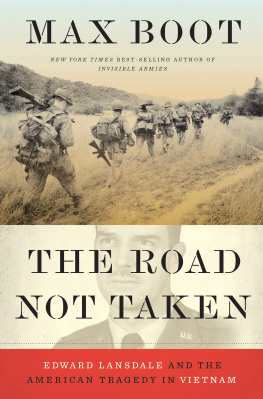INVISIBLE ARMIES
An Epic History of Guerrilla Warfare from Ancient Times to the Present
MAX BOOT

To the Council on Foreign Relations,
for making this book possible;
And to Victoria, Abigail, and William Boot,
for the good fortune of being their father.
An invisible army spread itself out over nearly the whole of Spain like a net from whose meshes there was no escape for the French soldier who for a moment left his column or his garrison. Without uniforms and without weapons, apparently the guerilleros escaped easily from the columns that pursued them, and it frequently happened that the troops sent out to do battle with them, passed through their midst without perceiving them.
COUNT MIOT DE MELITO (1858) 1
We... attack an enemy who is invisible, fluid, uncatchable.
COLONEL ROGER TRINQUIER (1961) 2
CONTENTS
Romans vs. Jews, AD 66
The Peloponnesian War, Alexander the Great in Central Asia, the Maccabees, and the Bar Kokhba Revolt, 426 BCAD 132
Tribal Wars of Mass Destruction
Mesopotamia, 23342005 BC
Persians vs. Scythians, 512 BC
The Origins of Counterinsurgency in Assyria and Rome, 1100 BCAD 212
The Barbarian Invasions, AD 370476
Ancient Chinese Warfare beyond Sun Tzu
Xiongnu vs. Han, 200 BCAD 48
Why the Weak Beat the Strong
Scotland vs. England, 12961746
The Counterinsurgents Advantage
Hussars, Pandours, and Rangers, 16481775
The Revolution against Britain, 17751783
The Peninsular War, 18081814
The Haitian War of Independence, 17911804
The Greek War of Independence, 18211832
Giuseppe Garibaldi and the Struggle for Italian Unification, 18331872
The Liberal Achievement
Why Did So Few Guerrillas Resist the European Advance?
The Forest Wars in Eastern North America, 16221842
Braves vs. Bluecoats, 18481890
The Holy War against Russia in Chechnya and Dagestan, 18291859
The First AngloAfghan War, 18381842
Britain and the Pashtuns, 18971947
Lyautey in Morocco, 19121925
Britains Near-Defeat in South Africa, 18991902
Why Imperialism Carried the Seeds of Its Own Destruction
The Assassins, AD 10901256
The Terrorist Who Helped Start the Civil War, 18561859
Ku Kluxers and the War against Civil Rights, 18661876
Anarchists, ca. 1880ca. 1939
The Nihilists on the Trail of Alexander II, 18791881
Socialist Revolutionaries in Russia, 19021917
The Irish War of Independence, 19191921
Sinners or Saints?
Blood Brothers and Brownshirts, 19141945
Lawrence of Arabia, 19161935
The Birth of the Special Forces in World War II
A Wayward Genius in Palestine, Abyssinia, and Burma, 19361944
Yugoslavia, 19411945, and the Limits of Scorched-Earth Counterinsurgency
Did Commandos Make a Difference?
The Slipping European Grip
Mao Zedongs Long March to Power, 19211949
The Indochina War, 19451954
The Algerian War of Independence, 19541962
Briggs, Templer, and the Malayan Emergency, 19481960
Why the British Succeededat Least Sometimes
The Guerrilla Mystique in the 1960s1970s
Edward Lansdale and the Huk Rebellion, 19451954
Lansdale and Diem, 19541956
The Limitations of Firepower in Vietnam, 19601973
Castros Improbable Comeback, 19521959
Ches Quixotic Quest, 19651967
The Raid on Entebbe and the Terrorism of the 1970s
What Terrorism Did and Did Not Achieve for the Palestinians
The End of the (Marxist) Affair in the 1980s
Tehran, Mecca, Islamabad, and Kabul, November 4December 24, 1979
The Red Army vs. the Mujahideen, 19801989
The Party of God in Lebanon, 19822006
Osama bin Laden and Al Qaeda, 19882011
Al Qaeda in Iraq since 2003
David Petraeus and the Surge, 20072008
The Failures and Successes of the Global Islamist Insurgency
L IKE PREDATORS READY for the hunt, the paratroopers came out of their hootches, their quarters, as twilight began to fall, their tan desert boots crunching softly on the silvery gravel spread over the barren soil of their compound. On went their gear: Kevlar helmets, M-4 assault rifles, 9-millimeter pistols, fire-retardant gloves, night-vision goggles, first-aid kits, ammunition pouches, walkie-talkies, and much else besides. The most unwieldy implement was their body armor, complete with shoulder and crotch coverings and SAPI plates (small arms protective inserts) in front, back, and around the sides. At least sixty pounds of added weight in allabout the same weight that a Roman legionnaire would have carried.
A short mission brief, then onto an unarmored truck that would spare them the half-mile walk to the front gate of Forward Operating Base Justice. After a brief drive, they hopped off. Four feet down from the rear of the truck. Out the gate. Into the warm spring air. Into the toxic smells drifting across the nearby Tigris River.
Monday, April 9, 2007. The Kadhimiya neighborhood of northwestern Baghdad.
This was the anniversary of the fall of Saddam Husseins regime. Although American troops had no trouble toppling the Iraqi army and Republican Guard, which fought exactly the kind of positional warfare that all conventional militaries prefer, they had found themselves stymied by armed groups ranging from Sunni jihadists to Shiite militias. Using simple weaponsAK-47s, rocket-propelled grenades, and, above all, the bombs that the American military dubbed IEDs (improvised explosive devices)a variety of militants had already killed over 3,300 Americans and wounded 25,000 more. Another 1,184 would die over the next four years and eight months. The death toll among Iraqis was far more horrific, eventually reaching more than 80,000 dead.1 Just a few months earlier, the terrible bloodletting in Baghdad had brought the country to the brink of all-out civil war.
American troops found their tactics and technology, still designed to defeat an opponent like the now defunct Red Army, woefully inadequate to deal with these new threats. In this sort of war, there were no flanks to turn, few bastions to storm, no capitals to seize. Only the grim daily challenge of battling an unseen foe that was everywhere and nowhere. A foe that struck with ruthless abandon and then melted into the population. A foe that hoped to goad the Americans into savage reprisals that would turn the population against them. This was the kind of enemy that Americans have battled before, from the jungles of the Philippines in the early 1900s to the rice paddies of Vietnam in the 1960s, but it is not an enemy that most soldiers feel comfortable in confronting.
Not until the end of 2006almost four years after the beginning of the Iraq Wardid the Army and Marine Corps finally release their first new field manual in decades (FM 3-24) dealing specifically with counterinsurgency operations. When General David H. Petraeus, who oversaw the writing of FM 3-24, was appointed the American commander in Iraq in early 2007, he began to implement its prescriptions. More troops were dispatched to Iraq and more of them began to move out of their remote Forward Operating Bases, where miles of concertina wire and concrete cut them off from contact with the society they were supposed to be pacifying. Troops began to take up residence in Joint Security Stations and Combat Outposts, where they could live and work alongside Iraqis. The emphasis began to shift from drive-bys in heavily armored Humvees to foot patrols that allow the soldiers to get out among the people and to gather the intelligence they need to hunt down insurgents.
Captain David Brunais, newly promoted from the rank of first lieutenant but still in command of a platoon, was a small part of this shift in strategy as he led eleven enlisted men and a sergeant from the Eighty-Second Airborne Division onto the darkened streets of Kadhimiya. This was their third patrol of the day in a heavily Shiite area where the few Sunni residents had been chased out months before. It was home to many sympathizers of Moqtada al Sadrs Jaish al Mahdi (Mahdist Army), an extremist Shiite group, as well as to a revered Shiite shrine heavily protected by local security forces. Much like the Mafia in John Gottis neighborhood, the Mahdists preferred to keep their own area quiet while exporting violence elsewhere. So this neighborhood was relatively secure by Iraqi terms. But that did not mean much. Shocking violence could erupt with no notice practically anywhere in this lawless land. Not even the Green Zone at the center of the city was secure. In a few days time, a suicide bomber would penetrate the Iraqi parliament in the Green Zone and kill a lawmaker in a heavily publicized attack.
Next page
